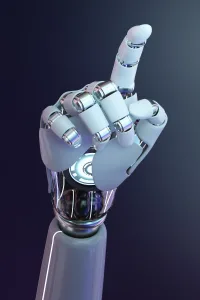What is OpenAI GPT?
OpenAI GPT is a language model created by OpenAI, a company founded in 2015 by tech industry titans such as Elon Musk and Sam Altman, among others. The company, which has received multibillion-dollar investments from companies like Greylock Partners, aims to develop advanced artificial intelligence with oversight and ethical considerations. GPT, which stands for Generative Pre-trained Transformer, is a family of machine learning models based on neural networks that are particularly adept at natural language processing. GPT’s fundamental advance comes from generative pre-training that enables it to learn and predict sequences of words by predicting what word comes next in a given sentence. OpenAI has since released several iterations of the model, including the recently unveiled GPT-3 model, which boasts over 175 billion parameters and has the potential to revolutionize fields such as content creation and automation. However, it has also sparked concerns about its potential misuse and future conflict, calling for heightened regulatory oversight.
History of OpenAI GPT

OpenAI GPT, an unsupervised transformer language model, was developed by OpenAI to improve natural language processing. In 2018, OpenAI started research on language models for pre-training deep learning models and identified Generative Pre-trained Transformers (GPTs) as a promising avenue. They released GPT-1 in June 2018, followed by GPT-2 in February 2019.
OpenAI GPT has had a significant impact on language models, with advances in areas such as text completion and machine translation. Tech companies like Microsoft and Alibaba have shown significant interest in OpenAI GPT and have incorporated it into their systems. The response within the tech industry has been largely positive.
Overall, OpenAI GPT has been a great leap in improving language models, enabling faster response times, and creating new possibilities for natural language processing. The development of OpenAI GPT shows the potential of machine learning models and their impact on language processing.
Early Days of OpenAI
OpenAI was founded in 2015 as a research company that aimed to advance artificial intelligence in a safe and beneficial manner. The company was established by several high-profile individuals, including Elon Musk, Greg Brockman, Trevor Blackwell, and others. The primary focus of OpenAI was to develop advanced artificial intelligence technologies that could work in harmony with humans. One of the early successes of OpenAI was its unsupervised transformer language model, which later became the GPT model. The model introduced a fundamental advance over previous language models by pre-training neural networks using unsupervised learning, which allowed for faster response times and more results-oriented output. Despite these early advancements, the company faced potential conflicts and regulatory oversight, given the multibillion-dollar investment from its parent company and the potential misuse of its technology.
Founding of OpenAI
OpenAI Inc. is a leading artificial intelligence research institution. The company was founded in 2015, with a mission to create AI models that can benefit humanity in a safe and trustworthy way. The founders of OpenAI are Sam Altman, Greg Brockman, Elon Musk, Ilya Sutskever, Trevor Blackwell, and Wojciech Zaremba.
Elon Musk, a technology entrepreneur, contributed $1 billion to OpenAI as a co-founder. His expertise in artificial intelligence, deep learning, and machine learning models strengthened OpenAI’s position as an innovative research company. Meanwhile, Sam Altman, a technology entrepreneur, and Ilya Sutskever, an AI researcher, were former Google engineers with vast knowledge of neural networks and deep learning models. Trevor Blackwell, another co-founder, was the founder of Anybots, while Wojciech Zaremba was a machine learning expert who specialized in deep learning models.
With the Azure-based supercomputing platform and the largest neural network in the world, the founders of OpenAI lead a team of researchers to create AI models that can imitate human-level intelligence. Their contributions have fueled the success of OpenAI as a fundamental advance in AI research.
Early Investments in OpenAI
OpenAI, the artificial intelligence research company co-founded by Elon Musk and others, has received significant early investments to fuel its groundbreaking work. In 2016, OpenAI secured a $1 billion investment from several prominent backers, including the founders of LinkedIn and Greylock Partners. This multibillion-dollar investment helped to establish OpenAI as a potential leader in the field of AI research.
In 2017, OpenAI received an additional $1 billion investment, this time led by the parent company of Chinese internet giant Tencent. This investment allowed OpenAI to expand its research efforts while also helping to establish its presence in the Chinese market.
More recently, in 2020, OpenAI secured a further $1 billion in funding led by Microsoft. This investment will reportedly be used to support OpenAI’s efforts to develop advanced AI models that can be safely and effectively deployed in the real world.
Overall, these early investments in OpenAI have helped to establish the company as a major player in the field of AI research and development. With support from leading tech companies and venture capitalists, OpenAI is well-positioned to continue innovating in the years to come.
Initial Research Focus on Language Models
OpenAI’s initial research focus was on language models, specifically natural language processing (NLP) and language modeling. Earlier approaches to language modeling, such as N-gram models, suffered from limitations such as a lack of contextual understanding, resulting in poor performance on many language tasks.
To address these limitations, OpenAI turned to recurrent neural networks (RNNs), which can capture the sequential nature of language. Long Short-Term Memory (LSTM) and Gated Recurrent Unit (GRU) architectures were then developed to address issues of vanishing gradients and improve the performance of RNNs.
From this foundation, OpenAI developed the Generative Pre-trained Transformer (GPT) model, with a focus on generative language tasks. The GPT series has made significant strides in language modeling, with each iteration boasting more parameters and improved performance. The latest model, GPT-4, potentially has 100 trillion parameters, allowing it to perform well on a wide variety of language tasks.
Overall, OpenAI’s research efforts in language models have contributed greatly to the field of NLP, and the development of more sophisticated models has the potential to revolutionize the way we interact with and understand language.
Generative Pre-trained Transformer (GPT) Development and Launch
 Generative Pre-trained Transformer (GPT) is one of the most powerful machine learning models developed by OpenAI. GPT is a neural network-based language model that has revolutionized the field of natural language processing (NLP). It is capable of generating human-like text, with applications in chatbots, language translations, and summarization. In this article, we will delve into the development and launch of GPT, starting from its early iterations to the latest GPT-4 model. We will also explore the potential of the latest GPT models and their impact on the future of NLP.
Generative Pre-trained Transformer (GPT) is one of the most powerful machine learning models developed by OpenAI. GPT is a neural network-based language model that has revolutionized the field of natural language processing (NLP). It is capable of generating human-like text, with applications in chatbots, language translations, and summarization. In this article, we will delve into the development and launch of GPT, starting from its early iterations to the latest GPT-4 model. We will also explore the potential of the latest GPT models and their impact on the future of NLP.
What is a GPT Model?
A GPT model, or Generative Pre-trained Transformer model, is a type of language model developed by OpenAI that uses deep learning techniques to understand and generate human-like language. The evolution of GPT models, starting from GPT-1 and progressing to GPT-4, has brought about substantial improvements in language understanding, generation, contextual comprehension, and factual accuracy.
Along with the increasing parameter sizes of these models, their applications have also expanded to tasks like machine translation, conversation generation, question answering, and document summarization. However, there are potential concerns associated with the use of GPT models, such as the potential for misuse to generate fake news and disinformation.
Nonetheless, GPT models represent a fundamental advance in natural language processing and generation. For example, GPT-3 has been instrumental in developing the language technology of the future. Its impressive capabilities have led to increased investment and interest from tech companies, multibillion-dollar funds, and regulatory authorities to ensure its responsible use. GPT models are important tools to promote the development and further advancement of language understanding, while mitigating their potential misuse by addressing these concerns.
Andrej Karpathy’s Contributions to the GPT Model Development
Andrej Karpathy played a significant role in the development of GPT models, particularly GPT-1, GPT-2, and GPT-3. His contributions involved refining models with fine-tuning and implementing innovative techniques to enhance model performance. He helped to refine GPT-1’s unsupervised transformer language model, resulting in an improvement in the quality of language generation. In the development of GPT-2, Karpathy assisted in finetuning the model’s parameters, resulting in better response times and improved quality of generated texts.
One of the major challenges Karpathy faced in the development of GPT models was the high demand for CPU cores to generate texts, limiting their deployment. To address this challenge, he introduced techniques for conserving resources, including reducing the activation size of the model and optimizing computation time, leading to faster response times and more efficient resource utilization.
Overall, Andrej Karpathy’s contributions have been instrumental in the development of GPT models, making them more efficient, user-friendly, and with enhanced language processing capability.
The Launch of the GPT Model in 2018 and its Impact on Language Models
In 2018, OpenAI launched the first version of its generative pre-trained transformer (GPT) language model. The release had a significant impact on language models, as it marked a fundamental advance in unsupervised transformer language models. GPT-1 was capable of generating text, translating complete phrases into other languages, and completing text fragments with reasonable accuracy. However, its limited capacity and precision prevented it from achieving human-like sentences.
The model was trained using a dataset of over 40 GB of text scraped from the internet. It utilized techniques such as masking, where the model had to predict the missing phrases placed between two words. Additionally, it employed next-sentence prediction, where the model predicted the following sentence in the text. These techniques allowed the model to recognize different meanings and relations between words, making it capable of generating coherent paragraphs of text.
Overall, the launch of the GPT-1 marked a significant milestone in the training of language models. Its success led to the development of the GPT family of models, including the recent GPT-3 model, which offers tremendous advancements in the capacity to generate human-like text.
Challenges Faced by the OpenAI Team During the Development Process
Developing advanced artificial intelligence (AI) models like OpenAI GPT is a complex process that involves overcoming various challenges that arise during its development. The OpenAI team faced several challenges during the creation of the GPT language models, which aimed to generate coherent text that mimicked human-level intelligence. These challenges ranged from hardware and software limitations to avoiding potential misuse and regulatory oversight. Understanding the challenges faced by the OpenAI team is crucial to appreciate the effort and innovation that resulted in the development of this model. In this article, we will delve into the challenges faced by the OpenAI team during the development process and how they overcame them.
Problems with Training Data Acquisition and Quality Control
During the development of the GPT language models, OpenAI faced significant challenges in the acquisition and quality control of training data. One problem was the sheer volume of data required to train these models effectively. OpenAI needed to collect vast amounts of text data from various sources but faced difficulties in ensuring its quality and consistency due to the varying levels of accuracy, relevance, and bias in the data.
These issues ultimately impacted the GPT model’s performance, as the quality of the training data directly influenced the model’s ability to generate coherent, useful, and unbiased text. To address these problems, OpenAI implemented several strategies, including developing automated tools to detect and eliminate low-quality data, collaborating with experts to evaluate the accuracy and relevance of data sources, and partnering with language experts to refine the quality of the training data.
Additionally, OpenAI created several tools to monitor and improve the quality of the GPT models, including the OpenAI microscope and OpenAI gym. The OpenAI microscope enables users to visualize and better understand the inner workings of the GPT models, while OpenAI gym provides a platform for testing and benchmarking the models’ performance. Despite these efforts, the challenges associated with data acquisition and quality control remain significant barriers to developing high-performing AI models.
Issues with Programming Languages Used for Developing Machine Learning Models
Developing neural network models requires a strong understanding of programming languages such as Python, C++, and Java. Python is the most commonly used language among researchers and developers due to its accessibility, ease of use, and large community support. C++ offers faster performance and is suitable for large-scale projects but requires more development time and expertise. Java is also a popular choice, particularly for web-based applications.
To facilitate the development process, various deep learning frameworks such as TensorFlow, Pytorch, and Keras have been created. TensorFlow is well-suited for large-scale projects with its high-performance computing capabilities, while Pytorch is a more user-friendly framework that emphasizes flexibility and simplicity. Keras is a high-level framework known for its user-friendly interface, making it an accessible choice for beginner developers.
Before neural network models can be trained, it is essential to preprocess and manage data effectively. This includes tasks such as data cleaning, transformation, and augmentation. Data cleaning entails removing irrelevant or erroneous data from datasets, while data transformation involves converting raw data into a format that is suitable for machine learning models. Data augmentation involves artificially increasing the size and variety of datasets to improve model accuracy and reliability. By adhering to best practices for data preprocessing and management, developers can build more effective and reliable neural network models.
Impact of GPT and Its Reception Amongst Tech Companies
 The development and deployment of the Generative Pre-trained Transformer (GPT) language model by OpenAI Inc. marks a fundamental advance in natural language processing and generative models. With its 3-dimensional model and unsupervised transformer language model, GPT has achieved remarkable results across multiple applications. However, as with all technological breakthroughs, concerns over potential conflict, fake news, and misuse can arise. In this context, it is worth exploring the impact of GPT and its reception amongst tech companies.
The development and deployment of the Generative Pre-trained Transformer (GPT) language model by OpenAI Inc. marks a fundamental advance in natural language processing and generative models. With its 3-dimensional model and unsupervised transformer language model, GPT has achieved remarkable results across multiple applications. However, as with all technological breakthroughs, concerns over potential conflict, fake news, and misuse can arise. In this context, it is worth exploring the impact of GPT and its reception amongst tech companies.
Multibillion-Dollar Investment in OpenAI LP By Greylock Partners and Microsoft
In recent years, OpenAI LP, a leading artificial intelligence company, has been the focus of significant investment from Greylock Partners and Microsoft. In 2019, Microsoft invested $1 billion in OpenAI, making one of the largest investments made in the AI field. Along with the investment, the two companies entered into an exclusive licensing agreement, allowing Microsoft to develop new technologies based on OpenAI’s research. The investment was seen as a vote of confidence in OpenAI’s work and its future potential.
In 2023, Microsoft announced that it would fund OpenAI with an additional $29 billion for forthcoming projects. This investment further strengthens the partnership between the companies and will undoubtedly drive innovation in the field of artificial intelligence. Prior to Microsoft’s investment, Greylock Partners also announced a $1 billion investment in OpenAI and later doubled its investment, signaling their belief in OpenAI’s potential for groundbreaking advancements in AI technology.
Overall, these multibillion-dollar investments show the potential in OpenAI’s research and capabilities in the development of new AI technologies, which could have a significant impact on various industries. The collaboration between Microsoft and OpenAI will likely lead to the creation of more advanced AI models, with faster response times and the potential to revolutionize the way we process natural language and generate synthetic text. Ultimately, the investments showcase the immense prospects within OpenAI and the AI industry as a whole.